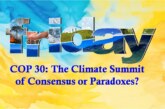
The Congress, convened under the banner “Powering Transformative Conservation,” represented a decisive shift from diagnosing crises to designing cures. With over 10,000 delegates from more than 160 nations, it was one of the largest environmental gatherings in history. But what distinguished it from its predecessors was not its scale it was its urgency. The Congress adopted 148 motions and resolutions, crafting what many are calling the most ambitious conservation roadmap in decades a twenty-year Strategic Vision 2045 that seeks to embed ecological resilience at the core of global governance.
Dr. Arvind Kumar*
In a year defined by converging planetary emergencies, the Earth’s distress has never been more palpable. The world today reels under what the United Nations terms the “triple planetary crisis” the interlocking emergencies of climate change, biodiversity loss, and pollution. Each crisis feeds the others in a vicious cycle: warming temperatures intensify habitat destruction, pollution degrades ecosystems, and collapsing biodiversity undermines the planet’s ability to regulate its own climate. The numbers are staggering; humanity now consumes the resources of 1.6 Earths each year, more than 75% of terrestrial ecosystems have been altered by human activity, and nearly one million species face extinction. Meanwhile, pollution claims close to nine million lives annually, and the global average temperature edges perilously close to breaching the 1.5°C threshold. These are not abstract statistics; they are the pulse readings of a planet in peril, signalling that the incrementalism of the past century has run its course. Against this sobering backdrop, the IUCN World Conservation Congress 2025, held in Abu Dhabi this October, became not merely a forum but a crucible, where the world sought to re-forge its covenant with nature.
Four years ago, the Marseille Congress of 2021 warned humanity that it was standing on the precipice. Abu Dhabi, by contrast, declared that the time for hesitation was over. The Congress, convened under the banner “Powering Transformative Conservation,” represented a decisive shift from diagnosing crises to designing cures. With over 10,000 delegates from more than 160 nations, it was one of the largest environmental gatherings in history. But what distinguished it from its predecessors was not its scale it was its urgency. The Congress adopted 148 motions and resolutions, crafting what many are calling the most ambitious conservation roadmap in decades a twenty-year Strategic Vision 2045 that seeks to embed ecological resilience at the core of global governance. It also re-elected Her Excellency Razan Khalifa Al Mubarak as President of the IUCN for a second term.
At the heart of this vision lie five interconnected pillars: scaling up resilient conservation action, reducing climate overshoot risks, delivering on equity, transitioning to nature-positive economies, and fostering disruptive innovation in leadership. Together, they signal a shift from conservation as a technical pursuit to a political, moral, and economic transformation. The Congress underscored that protecting the planet is not merely about saving species; it is about redefining the human enterprise itself. Each pillar drew from the hard lessons since Marseille: wildfires that erased ecosystems overnight, floods that displaced millions, and pandemics that proved the indivisibility of planetary and human health.
Stewardship, Not Stake-holding
Among the landmark decisions, Motion 108 drew global attention to the vast, unregulated trade in wild animals as pets. With over 90% support, IUCN members called for global guidelines to curb this industry, which strips millions of species from their habitats each year, dismantling ecosystems and accelerating extinction. It marked a shift from reactive conservation to precautionary governance preventing harm before it becomes irreversible. Equally consequential, Motion 87 established a framework for the responsible use of synthetic biology in conservation. By rejecting a blanket moratorium while mandating rigorous scientific evaluation and transparent oversight, the Congress struck a vital balance between innovation and caution placing IUCN at the forefront of conservation ethics in the age of biotechnology.
Perhaps the most transformative outcome came with Motion 42 the first in IUCN’s 77year history to place fossil fuel supply, not merely emissions, at the core of conservation policy. The motion calls for a just, equitable phase-out of coal, oil, and gas, and supports cooperation toward a Fossil Fuel Non-Proliferation Treaty. By acknowledging that fossil fuels drive over half of ocean acidification and habitat destruction, IUCN declared that the fight for biodiversity is inseparable from the struggle to end fossil dependence. Where Marseille hesitated to name the cause, Abu Dhabi called it out directly marking the moment conservation stepped decisively into the geopolitical arena.
The Congress also revisited unresolved legacies from Marseille particularly the fate of vulnerable marine ecosystems. The call for a moratorium on deep-sea mining was reaffirmed, and new protections were extended to seamounts and the mesopelagic zone, vast regions crucial for biodiversity and carbon sequestration but perilously unregulated. These measures recognize that the ocean, once seen as infinite, has limits and that its depths may hold the key to stabilizing the planet’s climate.
But beyond policies and resolutions, the beating heart of Abu Dhabi was human. For the first time in its history, IUCN hosted the World Summit of Indigenous Peoples and Nature, a landmark assembly of nearly 200 Indigenous leaders. Their message was clear that Indigenous Peoples are not stakeholders to be consulted but stewards who safeguard over 80% of global biodiversity. It symbolized a paradigm shift from conservation as exclusion to conservation as partnership. Scientific progress also featured prominently at the Congress. The release of the first-ever IUCN Green Status assessment for tigers illustrated a subtle yet powerful shift from cataloguing decline to measuring recovery potential. This “green lens” represents a philosophical evolution recognizing hope as a metric, not merely loss.
Leading Conservation through Action
For India, the Congress became a stage to showcase both legacy and leadership. Hon’ble Union Minister of State Kirti Vardhan Singh unveiled India’s first National Red List Roadmap and Vision 2025–2030, an ambitious initiative to assess over 11,000 species by 2030 through a nationally coordinated framework. As one of the planet’s 17 megadiverse countries, home to nearly eight percent of global flora and seven-and-a-half percent of fauna, India’s move signals its intent to lead conservation efforts in Asia. This initiative’s integration of Indigenous knowledge, youth engagement, and scientific collaboration demonstrates how biodiversity assessment can be democratized. Equally noteworthy was the formal recognition of India’s Dugong Conservation Reserve in Tamil Nadu’s Palk Bay 448 square kms of seagrass meadows serving as crucial habitat for the endangered “sea cow.” The IUCN resolution endorsing this reserve, passed with 98 percent support, commended India’s community-led restoration model, urging its replication across the Indian Ocean region. It was a fitting symbol of how conservation, when grounded in local stewardship, can generate global inspiration.
As the Congress drew to a close, delegates unanimously adopted the Abu Dhabi Call to Action, a sweeping declaration reaffirming that nature is the foundation of human and planetary well-being. It calls for strengthening multilateralism, embedding justice and equity in conservation, and scaling up finance and governance for nature-positive action. Its echoes are expected to resound through upcoming global gatherings from COP30 in Belém, Brazil, where climate negotiators will face pressure to align pledges with planetary boundaries, to the Second World Summit for Social Development in Doha, which will grapple with linking social progress and environmental integrity.
Way Ahead
Ultimately, the 2025 IUCN Congress did more than produce resolutions; it redrew the moral cartography of conservation. Where Marseille diagnosed, Abu Dhabi prescribed. It recognized that survival in the Anthropocene requires not incremental adaptation but transformational governance, a world order where nature is not a casualty of development but its cornerstone. The Congress left behind a vision, not of nostalgia for pristine wilderness, but of a planet reborn through restoration, innovation, and justice. Whether that vision becomes reality will depend not on future congresses but on the decisions made now in boardrooms, parliaments, classrooms, and communities. The clock, as Abu Dhabi made abundantly clear, is no longer ticking softly. It is demanding that humanity finally answer the call of its only home.






